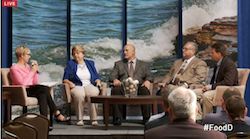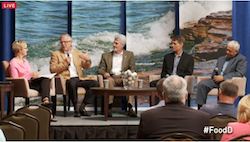The Ag industry had a welcome opportunity to discuss water quality issues and research this morning during the Food Dialogues: Toledo event that featured two panel discussions. The first panel, “Lessons from Toledo Water Crisis,” was moderated by Gail Hogan and featured Sandy Bihn, president, Toledo Lighthouse Society and executive director, Lake Erie Waterkeeper Inc.; Chuck Campbell, acting commissioner of water treatment, city of Toledo; Rich Nachazel, president, Destination Toledo, Inc,; and Adam Sharp, vice president of public policy, Ohio Farm Bureau Federation.

From left to right: Gail Hogan, retired Emmy award winning broadcast journalist; Sandy Bihn, president, Toledo Lighthouse Society and executive director, Lake Erie Waterkeeper Inc.; Chuck Campbell, acting commissioner of water treatment, city of Toledo; Rich Nachazel, president, Destination Toledo, Inc,; and Adam Sharp, vice president of public policy, Ohio Farm Bureau Federation
While water emergency plans were in place prior to the issue, it brought to light some areas that could be better addressed. Today Campbell said his organization has updated preparedness plans, and revised operating procedures along with implementing other measures. While Biln noted that they learned testing needed to be improved, she believes this has largely been solved through collaborative efforts among all industries that play a role in water quality.
But all panelists noted that more work needs to be done and there needs to be more funding to conduct extensive, ongoing research.
An important user of water is the agricultural industry and as Jack Fisher, executive vice president of the Ohio Farm Bureau Federation pointed out, the Ag industry is often accused of causing water quality issues. While he acknowledged that agriculture plays a role, there are other factors including those noted by John Knights, executive director for the Nature Conservancy, septic systems and water treatment facilities.
The two were joined by Jay Martin, lead faculty for the Global Water Initiative and the Field to Faucet Program, Ohio State University; and Terry McClure, vice chairman, Ohio Soybean Council Board in the second panel, “Balancing the Food and Water Question”.

From Left to Right: Gail Hogan, retired Emmy award winning broadcast journalist; Jack Fisher, executive vice president, Ohio Farm Bureau Federation; Josh Knights, executive director, The Nature Conservancy in Ohio; Jay Martin, lead faculty for the Global Water Initiative and the Field to Faucet Program, Ohio State University; and Terry McClure, vice chairman, Ohio Soybean Council Board
In the efforts among the Ag industry, money has not been a barrier. Fisher said they have received federal and state funding and the state’s Ag industry has allocated $2 million for water quality research because the industry knows that research is a major component of solutions.
